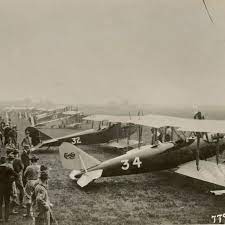On October 8, 1919, the United States witnessed an exciting and groundbreaking event in aviation history: the National Air Races. Held at Mitchel Field in Long Island, New York, this event marked the first major air race in the country and showcased the rapid progress of aviation technology in the aftermath of World War I. The National Air Races brought together some of the most skilled aviators of the time, who competed in various categories and events. The races included speed trials, endurance challenges, and precision flying contests, captivating both participants and spectators alike. One of the most notable moments of the day was the participation of Army Air Service pilots in the races. These pilots, who had gained valuable experience during the war, showcased their skills and demonstrated the military potential of aviation. Their presence added a sense of prestige and excitement to the event. The National Air Races also served as a platform to promote commercial aviation and the development of aeronautics. Aircraft manufacturers, such as Curtiss, Boeing, and Martin, showcased their latest models and innovations. The races provided an opportunity for these companies to demonstrate the capabilities of their aircraft and attract potential customers. The event attracted a large crowd, including aviation enthusiasts, military personnel, and curious onlookers. Spectators marveled at the speed and agility of the aircraft as they zipped through the skies. The races ignited a sense of awe and wonder, as people witnessed the potential of aviation and its ability to revolutionize transportation and travel. The National Air Races of 1919 also had a significant impact on the future of aviation. The event helped foster public interest and support for further advancements in aeronautics. It encouraged investment in research and development, leading to improvements in aircraft design, engine technology, and safety measures. The success of the National Air Races prompted the establishment of the National Air Races Committee, which organized subsequent air races and competitions in the following years. These events played a crucial role in the growth and development of the aviation industry, paving the way for the emergence of commercial airlines and the establishment of air travel as a viable means of transportation. Furthermore, the races served as a catalyst for the growth of aviation infrastructure in the United States. Airports and airfields were expanded and improved to accommodate the increasing demand for air travel. The National Air Races helped to solidify the importance of aviation in the national consciousness and laid the groundwork for the future of the industry. October 8, 1919, marked a significant milestone in American aviation history with the inaugural National Air Races. The event showcased the skill and daring of aviators, highlighted the progress of aviation technology, and fueled public enthusiasm for the future of flight. The races played a pivotal role in the development of commercial aviation, inspiring advancements in aircraft design and infrastructure. The legacy of the National Air Races continues to resonate in the modern aviation industry, where speed, precision, and innovation remain at the forefront of progress.
8 Oct, 1919 U.S.A. Air Races
